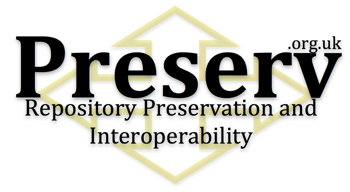

|
Latest...
|
|
Project Partners PRESERV 2 is funded by JISC within its capital programme in response to the September 06 call (Circular 04/06), Repositories and Preservation strand PRESERV was originally funded by JISC within the 4/04 programme Supporting Digital Preservation and Asset Management in Institutions, theme 3: Institutional repository infrastructure development MORE INFORMATION? EMAIL: Steve Hitchcock, Project Manager TEL: +44 (0)23 8059 3256 FAX: +44 (0)23 8059 2865 PRESERV Project, IAM (Intelligence, Agents, Multimedia) Group, Department of Electronics & Computer Science, University of Southampton, Highfield, Southampton SO17 1BJ, UK |
| Preservation Services |
|
Active PreservationMarch 2009 - Preservation services, in Preserv, focus on managing file and storage formats for repositories. This is the most technical area of this work, and therefore requires tools to automate the processes and services to assist in their deployment. To find out why formats matter, see this RSP/Preserv tutorial briefing paper. Sub-dividing technical preservation processes: seamless flow This approach is modelled on 'seamless flow' elaborated by the National
Archives (TNA), and involves 'active preservation':
Preserv got as far as stage 2, that is, we can identify the objects in a repository, and we have shown we can invoke a current registry to classify the digital objects and present a hierarchy of risk scores for a repository. Critically, the registry doesn't yet have any data for the risks. It has recently been developed and updated with the facility to hold these risk analyses (PRONOM v7), and the detailed criteria have been elaborated, but the analyses have not been done yet. It was intended such analyses would be done for selected formats that occur commonly in, or have particular relevance to, institutional repositories. An important outcome from Preserv is that we provide some test results for the processes developed to date. The significance of this is the tools we have used from TNA - including DROID (digital record object identification service), an automated downloadable service, as well as PRONOM, the technical knowledge registry - are in the public domain and widely used, and these results inform the reliability and optimum use of the tools going forward. It is particularly vital that tools intended to improve the reliability of digital data management are themselves shown to be reliable. |
| 1/8 | Testing format classification ---> |







